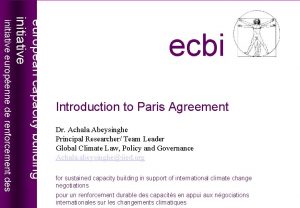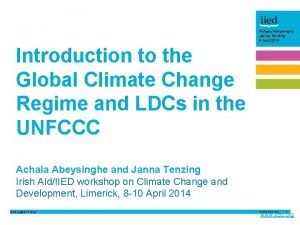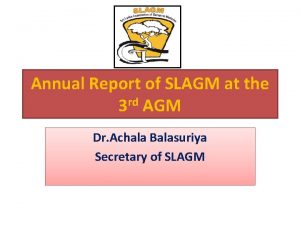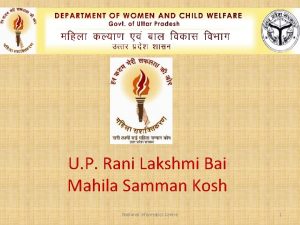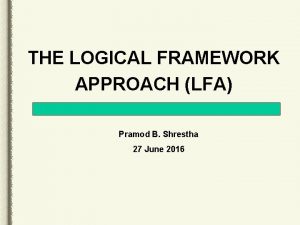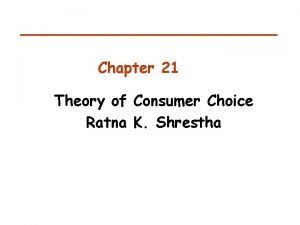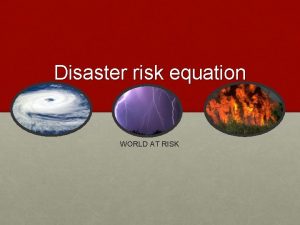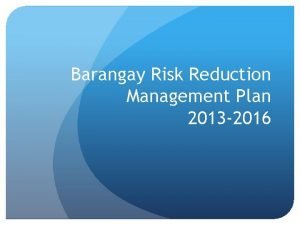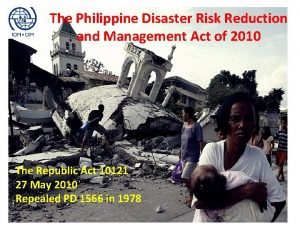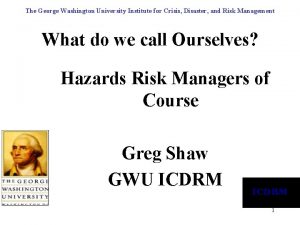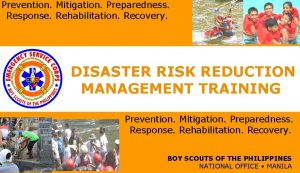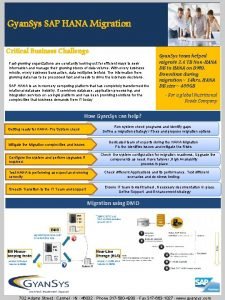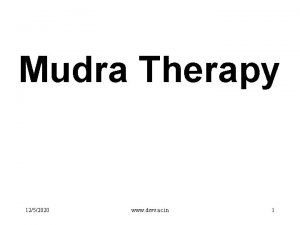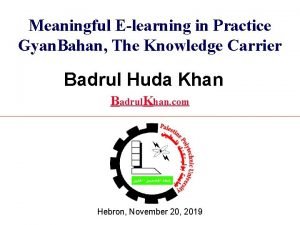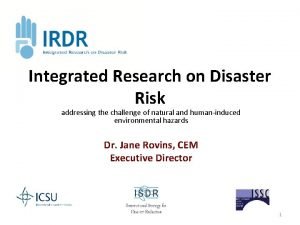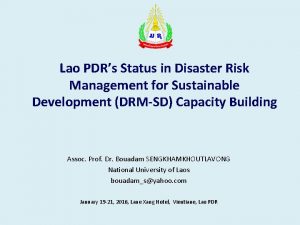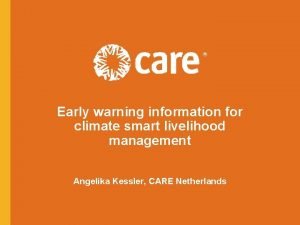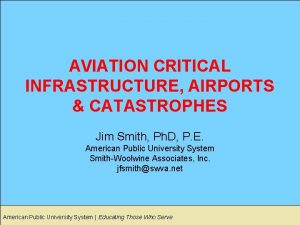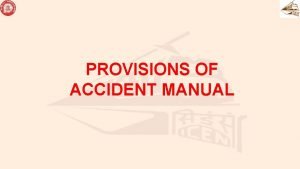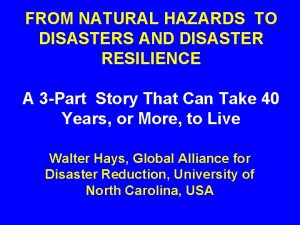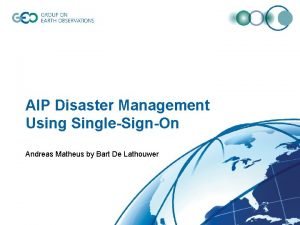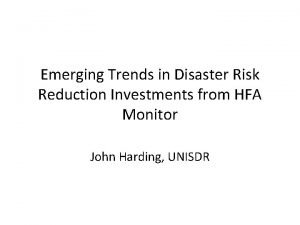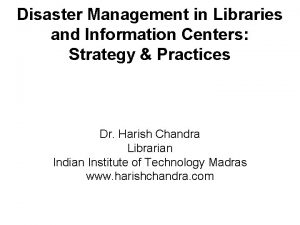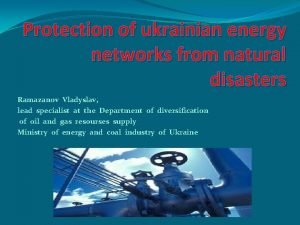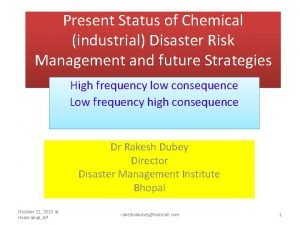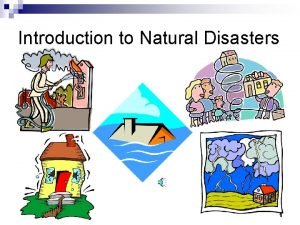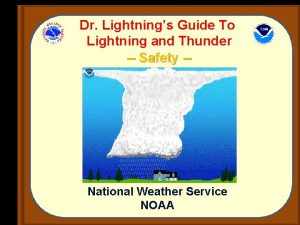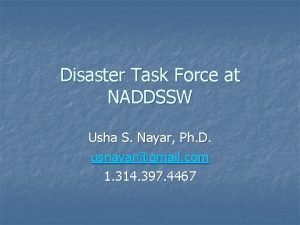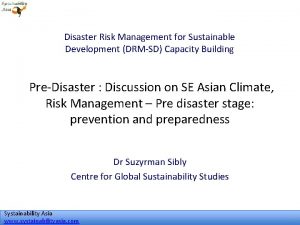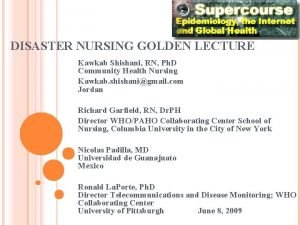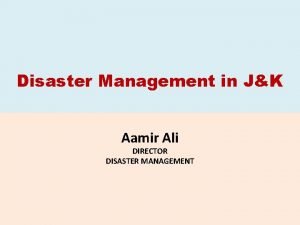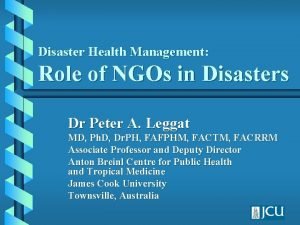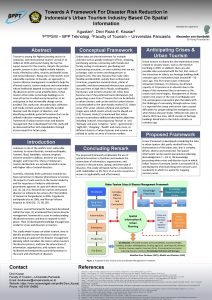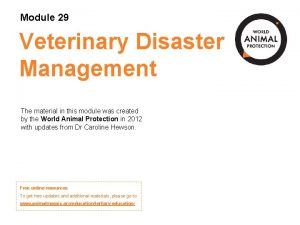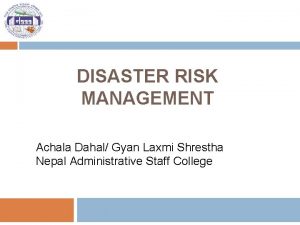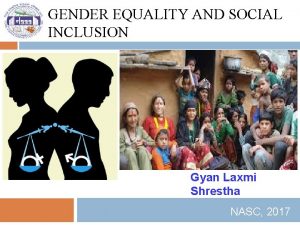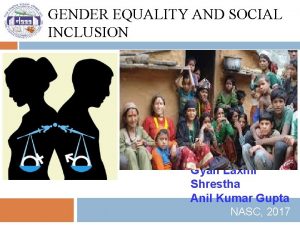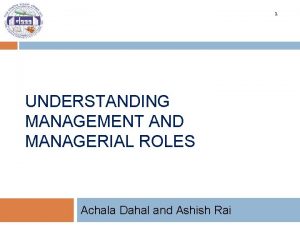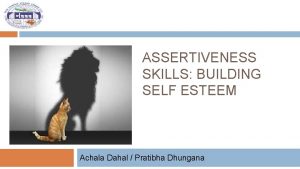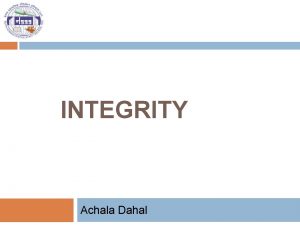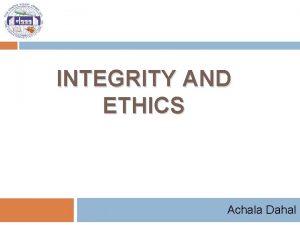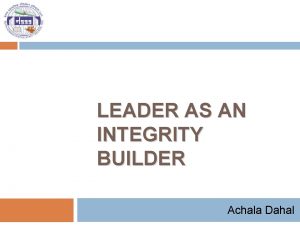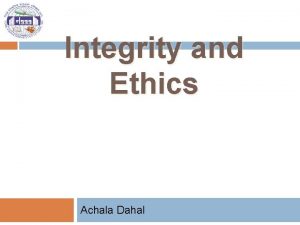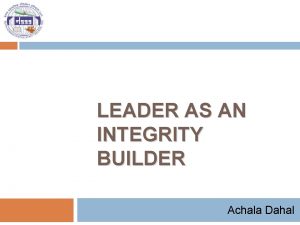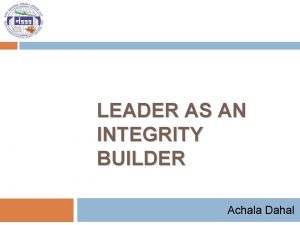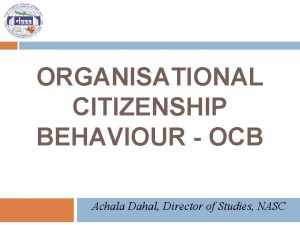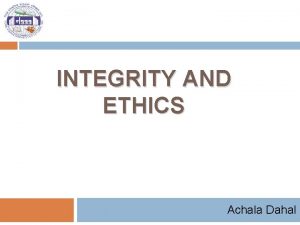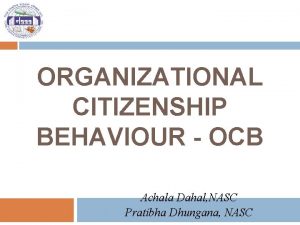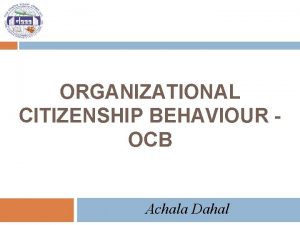DISASTER RISK MANAGEMENT Achala Dahal Gyan Laxmi Shrestha


















































- Slides: 50

DISASTER RISK MANAGEMENT Achala Dahal Gyan Laxmi Shrestha Nepal Administrative Staff College

Learning objectives 2 Having gone through this session participants will be able to: Tell the operational definition of disaster Prepare a list of basic terminologies and their brief description Understanding of Disaster Risk Management Mainstreaming Disaster in planning 2021 -10 -30

3 Basic Terminologies 2021 -10 -30

Hazard A dangerous phenomenon, substance, human activity or condition that may cause loss of life, injury or other health impacts, property damage, loss of livelihoods and services, social and economic disruption, or environmental damage.

Types of Hazard Natural Hazards : part of the natural environment 1. Hydro-meteorological hazards § Typhoons § Storm surges § Floods 2. Geologic hazards § Earthquake § Landslides 3. Oceanic Hazards § Tsunami § Tidal Surges 4. Biological Hazards § Epidemics § Insect Infestation

Types of Hazard Man-made Hazards : human induced hazards 1. Socio-natural Hazards § Forest denudation § Famine § Increased occurrences of natural hazards 2. Socio-political Hazards § War § Civil unrest 3. Technological Hazards § Transport accidents § Toxic substance poisoning § Contamination of food and water sources

Disaster A serious disruption of the functioning of a community or a society involving widespread human, material, economic or environmental losses and impacts, which exceeds the ability of the affected community or society to cope using its own resources.

Exposure People, property, systems, or other elements present in hazard zones that are thereby subject to potential losses

Vulnerability The characteristics and circumstances of a community, system or asset that make it susceptible to the damaging effects of a hazard. A set of prevailing or consequential conditions which adversely affect people’s ability prevent, mitigate, prepare for and respond to hazardous events.

Physical / Material Vulnerability Factors of Vulnerability § Hazard-prone location of community houses, farmlands, infrastructure, basic services § Design and construction materials of houses and buildings § Insecure and risky sources of livelihood § Lack of basic services: education, health, safe drinking water, shelter, sanitation, roads, electricity, communication § Exposed to violence (domestic, armed conflicts) § Age and disability

Factors of Vulnerability Social / Organizational Vulnerability § Weak family / kinship structures § Lack of leadership and initiative to solve problems or conflicts § Exclusion of certain groups from decisionmaking or unequal participation in community affairs § Absence or weak community organizations § Social status (castes, ethnicity, gender) § Neglect from government and civil institutions

Factors of Vulnerability Motivational / Attitudinal Vulnerability § § § Negative attitude towards change Passivity, fatalism, hopelessness Lack of initiative Dependence on external support Lack of knowledge and skills Extremism

Capacity The combination of all the strengths, attributes and resources available within a community, society or organization that can be used to achieve agreed goals. …. resources, means and strengths, which exist in households and communities and which enable them to cope with, withstand, prepare for, prevent, mitigate, or quickly recover from a disaster.

Factors of Capacity Physical / Economic Capacity § Money / Cash § Real Properties § Stable sources of income and livelihood § Safe infrastructures § Food security § Balanced natural environment § Limited number of hazards events

Factors of Capacity Social / Organizational Capacity § Relationship with relatives and family § People – centered government § Strong civil society / empowered community § Functional community based and civic organizations § Optimum availability of basic social and health services § Strong social networks and institutions

Factors of Capacity Motivational / Attitudinal Capacity § § § § Knowledgeable and skillful Confidence and self-esteem Proactive attitude Open to change and new ideas Continual learning Building on experiences Positive perception in life

Disaster Risk The potential disaster losses, in lives, health status, livelihoods, assets and services, which could occur to a particular community or a society over some specified future time period.

HAZARDS ? DISASTERS? WHICH IS WHICH?







what is not a § Earthquakes § Floods § Landslides § Fire § Drought § Typhoon disaster? If no societal elements are affected; like people, services, infrastructures and livelihoods. These remain as natural hazards.

When do hazards become disasters? § Hazards impact societal elements; § Level of vulnerability conditions is high; § Very low capacity to prepare for and cope with the hazard events.

HAZARD X CAPACITY VULNERABILITY : DISASTER RISK

Capacity Vulnerability Risk Hazard


Take Away Messages § Hazards become disasters when it impacts society; § Hazards will always be with us, these don’t have to become disasters; § Disasters don’t just happen, it is caused by several factors; § Vulnerability contributes to disasters § Vulnerability is about the lack of capacity § Capacity is the opposite of vulnerability; § Capacity is about resources; § Disaster risks is related to hazards, vulnerability and capacity

HAZARDS will always be with us, but these don't have to become DISASTERS!

Critical Infrastructure The primary physical structures, technical facilities and systems which are socially, economically or operationally essential to the functioning of a society or community, both in routine circumstances and in the extreme circumstances of an emergency.

Prevention The outright avoidance of adverse impacts of hazards and related disasters.

Mitigation The lessening or limitation of the adverse impacts of hazards and related disasters.

Preparedness The knowledge and capacities developed by governments, professional response and recovery organizations, communities and individuals to effectively anticipate, respond to, and recover from, the impacts of likely, imminent or current hazard events or conditions.

Response The provision of emergency services and public assistance during or immediately after a disaster in order to save lives, reduce health impacts, ensure public safety and meet the basic subsistence needs of the people affected

37 Recovery The restoration, and improvement where appropriate, of facilities, livelihoods and living conditions of disasteraffected communities, including efforts to reduce disaster risk factors. 2021 -10 -30

Disaster Management (DM), Disaster Risk Reduction (DRR) Disaster Risk Management (DRM),

Disaster Management is a collective term encompassing all aspects of planning for and responding to disasters. Refers to the management of both the risks and consequences of disasters.

Disaster Risk Reduction The conceptual framework to: § minimize vulnerabilities and disaster risks throughout a society; § avoid or to limit the adverse impacts of hazards; § done within the broad context of sustainable development.

DRR Framework 1. Risk awareness and assessment § VCA § Emergency assessments § DRM planning 2. Knowledge development § IEC materials § Training and public awareness § Research and documentation 3. Public commitment and institutional frameworks § Community based approaches § Policy development and implementation 4. Application of measures § Mitigation § Prevention § Recovery 5. Early Warning § Early warning systems In the broader context of sustainable developme nt

Disaster Risk Management The systematic process of using administrative directives, organizations, and operational skills and capacities to implement strategies, policies and activities to lessen the adverse impacts of hazards and the possibility of disaster.

Graphic view: mainstreaming Side stream Development DRM/CCA Mainstream

Mainstreaming DRM A process of incorporating and integrating the practices of; Preparedness Prevention Mitigation Response Recovery in everyday life of people

Things to do mainstreaming DRM Awareness raising Developing an enabling environment Developing tools and methodologies Training & technical support Change in operational practice Measuring progress Learning & experience sharing and improvement

Mainstreaming DRM and Sustainable development DRR Every day Prevention Mitigation Preparedness DRM DM Events Response Operations Recovery Activities

Take Away Messages § DM = a collective term of all disaster related activities § DRM = a systematic process of using resources to manage the risk of disasters § DRR = a conceptual framework to reduce vulnerabilities in the context of sustainable development

Disaster as a Social Phenomenon ROOT CAUSES DYNAMIC FACTORS UNSAFE CONDITIONS Social injustice Lack of basic services Illiteracy Unequal use of resources Discrimination Economic monopoly Political dogma (beliefs) Unchecked spread of disease Displacement Unsustainable use of common resources Ecological imbalance Political turmoil Hazard prone locations of residence and livelihood Concentration of wealth HAZARDS Decreasing access to shelter, food and water Emergence of armed groups DISASTER Floods Landslides Earthquake Fire Health related Conflict

Disaster as a Social Phenomenon CHALLENGING UNDERLYING CAUSES ADDRESSING DYNAMIC PRESSURES CREATING SAFER CONDITIONS Addressing underlying causes through social, economic, political reforms Reduction of pressures through sustainable development interventions Safer conditions through disaster preparedness, response and recovery interventions HAZARDS Disaster Risk Management Hazard mitigation and prevention

It’s time for Feedback Achala Dahal Nepal Administrative Staff College Jawalakhel, Lalitpur Cell 9841890989 Email: achala. dahal@nasc. org. np
 Achala abeysinghe
Achala abeysinghe Achala abeysinghe
Achala abeysinghe Achala balasuriya
Achala balasuriya Rani laxmi bai samman kosh
Rani laxmi bai samman kosh Proyecto 103 puerto rico
Proyecto 103 puerto rico Effekr
Effekr Dr rajendra shrestha
Dr rajendra shrestha Sezma shrestha
Sezma shrestha Ratna k. shrestha
Ratna k. shrestha Disaster equation
Disaster equation Barangay disaster risk reduction management plan
Barangay disaster risk reduction management plan Illustrate a salient feature of pdrrm act of 2010
Illustrate a salient feature of pdrrm act of 2010 George washington crisis management
George washington crisis management Republic act 10121
Republic act 10121 Gyan vahini
Gyan vahini Gyan sys
Gyan sys Gyan mudra
Gyan mudra Gyan ki bahan
Gyan ki bahan Market risk assessment
Market risk assessment Key risk indicators template
Key risk indicators template Risk map risk management
Risk map risk management Integrated research on disaster risk
Integrated research on disaster risk Conclusion of disaster management ppt
Conclusion of disaster management ppt Early warning system in disaster management
Early warning system in disaster management Records management disaster recovery plan
Records management disaster recovery plan What is a disaster
What is a disaster Disaster management centre sri lanka
Disaster management centre sri lanka Civil defence disaster management
Civil defence disaster management Conclusion of disaster management
Conclusion of disaster management Disaster management
Disaster management 4 pillars of disaster management
4 pillars of disaster management Disaster management conclusion
Disaster management conclusion Emerging trends in disaster mitigation
Emerging trends in disaster mitigation Disaster management in libraries and information centres
Disaster management in libraries and information centres Conclusion on disaster management ppt
Conclusion on disaster management ppt Hotmail
Hotmail Objective of disaster management
Objective of disaster management Conclusion of disaster management
Conclusion of disaster management Poster on disaster management with slogan
Poster on disaster management with slogan Conclusion on disaster management
Conclusion on disaster management Disaster management and sustainable development
Disaster management and sustainable development Nurse role in disaster management
Nurse role in disaster management Disaster management jk
Disaster management jk Ngo in disaster management
Ngo in disaster management Four pillars of disaster management
Four pillars of disaster management Towards a framework for tourism disaster management
Towards a framework for tourism disaster management Veterinary disaster management
Veterinary disaster management Risk projection in software engineering
Risk projection in software engineering Risk avoidance
Risk avoidance Relative risk calculation
Relative risk calculation Residual risk and secondary risk pmp
Residual risk and secondary risk pmp
